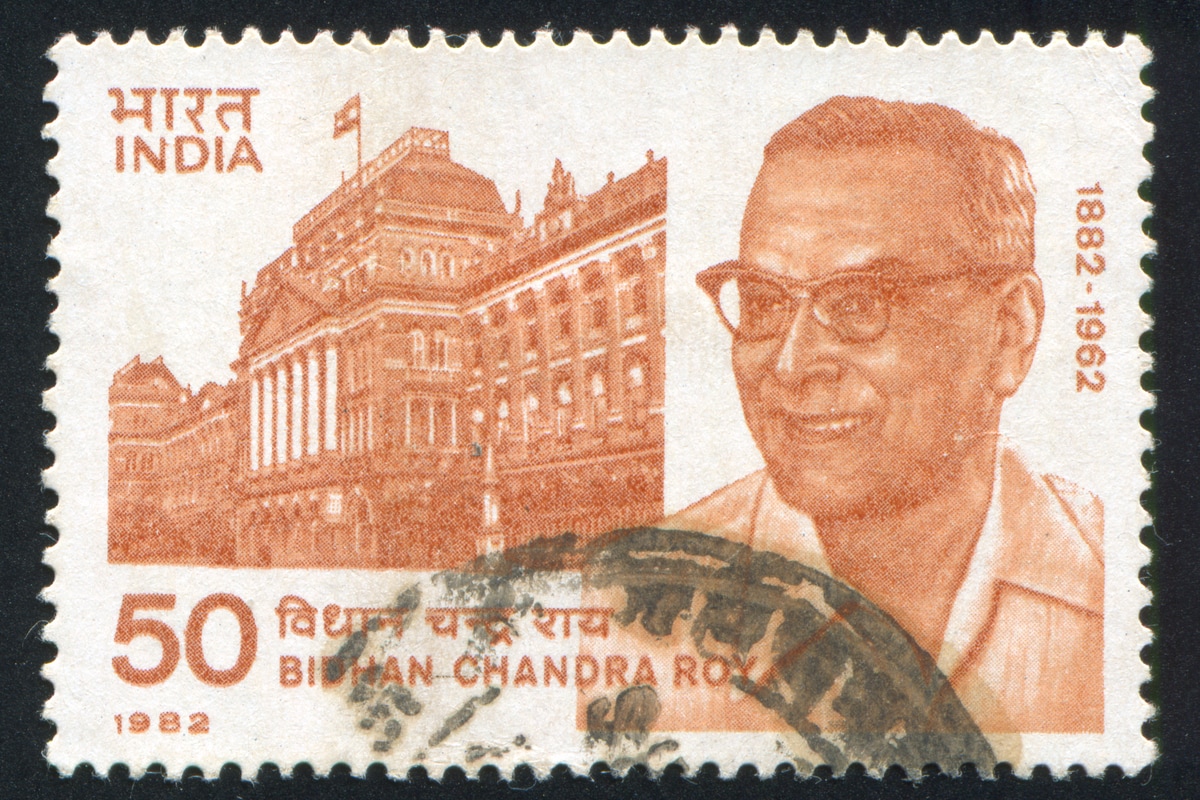 In India, National Doctor's Day honours Dr Bidhan Chandra Roy, an internationally recognised medical practitioner who worked as a physician, a freedom fighter, an educator, and a politician.
In India, National Doctor's Day honours Dr Bidhan Chandra Roy, an internationally recognised medical practitioner who worked as a physician, a freedom fighter, an educator, and a politician.from Top Lifestyle News- News18.com https://ift.tt/3y9nFCt
 In India, National Doctor's Day honours Dr Bidhan Chandra Roy, an internationally recognised medical practitioner who worked as a physician, a freedom fighter, an educator, and a politician.
In India, National Doctor's Day honours Dr Bidhan Chandra Roy, an internationally recognised medical practitioner who worked as a physician, a freedom fighter, an educator, and a politician. National Doctors Day 2021: Indian Medical Association intends to generate funds through donations from its members and the public, especially recognised institutions
National Doctors Day 2021: Indian Medical Association intends to generate funds through donations from its members and the public, especially recognised institutions Having sung for the megastar in many films, Sudesh Bhosle says he was proud to be "the voice of Amitabh Bachchan".
Having sung for the megastar in many films, Sudesh Bhosle says he was proud to be "the voice of Amitabh Bachchan". Happy Doctors' Day 2021: Make this day special for the doctors by sharing the word of appreciation for their endless commitment towards the community by sending messages, greetings, and wishes.
Happy Doctors' Day 2021: Make this day special for the doctors by sharing the word of appreciation for their endless commitment towards the community by sending messages, greetings, and wishes. National Doctors' Day 2021: As per the data available till June 2, a total of 1,372 doctors lost their life during COVID-19 duty
National Doctors' Day 2021: As per the data available till June 2, a total of 1,372 doctors lost their life during COVID-19 duty National Doctors' Day 2021: From Amitabh Bachchan to Shahid Kapoor, Bollywood actors have given great performances in the role of a doctor.
National Doctors' Day 2021: From Amitabh Bachchan to Shahid Kapoor, Bollywood actors have given great performances in the role of a doctor. International Joke Day encourages people to keep all there problems on one side and share jokes and humorous videos with others
International Joke Day encourages people to keep all there problems on one side and share jokes and humorous videos with others With her stint at MTV, Rhea paved her way to acting and made debut with Telugu movie Tuneega Tuneega
With her stint at MTV, Rhea paved her way to acting and made debut with Telugu movie Tuneega Tuneega National Doctors' Day 2021: During these trying times, many doctors also started providing free online consultation services for those people who were unable to afford the treatment
National Doctors' Day 2021: During these trying times, many doctors also started providing free online consultation services for those people who were unable to afford the treatment In preparation for a possible third wave of COVID-19, with predictions of children being impacted to a greater degree, Bollywood actor Huma Qureshi, along with Save the Children, will be setting up a 30-bed pediatric ward in New Delhi. Following the first two waves where there has been an increase in infections amongst the younger population, child-specific needs are the focus of this new initiative called 'Breath of Life'. While preparing the new ward, special care is being taken to make it child-friendly, as that helps in healing. The walls are being painted in ways to make them pleasant and friendly for children.
In preparation for a possible third wave of COVID-19, with predictions of children being impacted to a greater degree, Bollywood actor Huma Qureshi, along with Save the Children, will be setting up a 30-bed pediatric ward in New Delhi. Following the first two waves where there has been an increase in infections amongst the younger population, child-specific needs are the focus of this new initiative called 'Breath of Life'. While preparing the new ward, special care is being taken to make it child-friendly, as that helps in healing. The walls are being painted in ways to make them pleasant and friendly for children. After two years of the release of the hit film 'Gully Boy', filmmakers Zoya Akhtar and Reema Kagti have come up with a surprise for fans. On Wednesday, Zoya and Reema under their production banner, Tiger Baby Films, launched the 'The Gully Grove Challenge' on social media, asking users to create a reel video of 30 seconds of the super hit song from the movie 'Apna Time Aayega' to express themselves creatively. This could involve rapping, dancing, running, driving, cooking -- whatever people can imagine.
After two years of the release of the hit film 'Gully Boy', filmmakers Zoya Akhtar and Reema Kagti have come up with a surprise for fans. On Wednesday, Zoya and Reema under their production banner, Tiger Baby Films, launched the 'The Gully Grove Challenge' on social media, asking users to create a reel video of 30 seconds of the super hit song from the movie 'Apna Time Aayega' to express themselves creatively. This could involve rapping, dancing, running, driving, cooking -- whatever people can imagine. Yeh Hai Mohabbatein fame actress Divyanka Tripathi has reunited with the love of her life, husband Vivek Dahiya. The actress was in Cape Town to shoot for filmmaker Rohit Shetty's adventure-based reality show Khatron Ke Khiladi 11. Now that she is back, she is spending quality time with her husband. Vivek Dahiya took to Instagram to share a lovestruck picture with the TV actress. He captioned it: "Let’s catch up! #TogetherAgain."
Yeh Hai Mohabbatein fame actress Divyanka Tripathi has reunited with the love of her life, husband Vivek Dahiya. The actress was in Cape Town to shoot for filmmaker Rohit Shetty's adventure-based reality show Khatron Ke Khiladi 11. Now that she is back, she is spending quality time with her husband. Vivek Dahiya took to Instagram to share a lovestruck picture with the TV actress. He captioned it: "Let’s catch up! #TogetherAgain." National Doctors’ Day 2021 is the best occasion to thank all the doctors, nurses and healthcare professionals in your life for all that they do for us
National Doctors’ Day 2021 is the best occasion to thank all the doctors, nurses and healthcare professionals in your life for all that they do for us Even in the harshest working conditions, they continue to persevere six days a week, to help us send and receive our mails
Even in the harshest working conditions, they continue to persevere six days a week, to help us send and receive our mails Every year the day is celebrated as National Doctor’s Day, National Postal Worker Day, National CA Day, GST Day 2021 and International Joke Day
Every year the day is celebrated as National Doctor’s Day, National Postal Worker Day, National CA Day, GST Day 2021 and International Joke Day National Doctor’s Day: Anandibai Gopalrao Joshi got her degree in western medicine from Woman's Medical College in Pennsylvania, one of the two medical colleges for women in the world
National Doctor’s Day: Anandibai Gopalrao Joshi got her degree in western medicine from Woman's Medical College in Pennsylvania, one of the two medical colleges for women in the world National Doctors' Day marks the birth and death anniversary of the legendary physician Dr. Bidhan Chandra Roy
National Doctors' Day marks the birth and death anniversary of the legendary physician Dr. Bidhan Chandra Roy National Doctors' Day 2021: Pandemic has once again reminded us about the contributions and sacrifices made by doctors and healthcare workers around the globe
National Doctors' Day 2021: Pandemic has once again reminded us about the contributions and sacrifices made by doctors and healthcare workers around the globe Filmmaker Rakeysh Omprakash Mehra on Wednesday said it was "liberating" for him to direct "Toofaan", which he believes is more than just a sports drama. The movie, which will release on Amazon Prime Video on July 16, reunites Mehra with Farhan Akhtar, the star of his 2013 movie "Bhaag Milkha Bhaag". Billed as an inspirational sports drama of a goon called Aziz Ali aka Ajju Bhai (Akhtar), from the streets of Dongri, "Toofaan" is set against the backdrop of boxing and charts the fall and triumphant comeback of its lead.
Filmmaker Rakeysh Omprakash Mehra on Wednesday said it was "liberating" for him to direct "Toofaan", which he believes is more than just a sports drama. The movie, which will release on Amazon Prime Video on July 16, reunites Mehra with Farhan Akhtar, the star of his 2013 movie "Bhaag Milkha Bhaag". Billed as an inspirational sports drama of a goon called Aziz Ali aka Ajju Bhai (Akhtar), from the streets of Dongri, "Toofaan" is set against the backdrop of boxing and charts the fall and triumphant comeback of its lead. Singer Demi Lovato is all set to launch her talk show on July 30. "The Demi Lovato" show aims to focus on a variety of topics including sex and body positivity, feminism, gender issues and mental health. Guests lined up to feature on the show include Jameela Jamil, Lucy Hale, Nikita Dragun, according femalefirst.co.uk.
Singer Demi Lovato is all set to launch her talk show on July 30. "The Demi Lovato" show aims to focus on a variety of topics including sex and body positivity, feminism, gender issues and mental health. Guests lined up to feature on the show include Jameela Jamil, Lucy Hale, Nikita Dragun, according femalefirst.co.uk. Kalashtami 2021: The day holds a special significance in the Hindu religion as it is dedicated to Lord Kalabhairav
Kalashtami 2021: The day holds a special significance in the Hindu religion as it is dedicated to Lord Kalabhairav Bollywood actress Mandira Bedi's filmmaker husband Raj Kaushal passed away on Wednesday morning after succumbing to a heart attack. As per reports, he was at his home when he suffered the heart attack. The news left not just the fans but also their friends and colleagues from the industry are shocked as the pictures of the two of them partying with their friends were circulated on social media on Sunday. Bigg Boss 11 winner Shilpa Shinde also took to her Instagram account to express grief over Raj's sudden demise. Raj was Shilpa's first director with whom she worked.
Bollywood actress Mandira Bedi's filmmaker husband Raj Kaushal passed away on Wednesday morning after succumbing to a heart attack. As per reports, he was at his home when he suffered the heart attack. The news left not just the fans but also their friends and colleagues from the industry are shocked as the pictures of the two of them partying with their friends were circulated on social media on Sunday. Bigg Boss 11 winner Shilpa Shinde also took to her Instagram account to express grief over Raj's sudden demise. Raj was Shilpa's first director with whom she worked. Television's most popular singing reality show Indian Idol contestants have been able to garner a massive fanbase for themselves. They have been receiving the utmost love and praise from audiences all around the world. Recently, Uttarakhand Chief Minister Tirath Singh Rawat met Indian Idol contestant Pawandeep Rajan and described him as a source of inspiration for the youths. The Chief Minister on Tuesday said Pawandeep's singing has introduced the country to the folk music of Uttarakhand and he has made the state proud by becoming one of the strongest contestants on the popular music reality show.
Television's most popular singing reality show Indian Idol contestants have been able to garner a massive fanbase for themselves. They have been receiving the utmost love and praise from audiences all around the world. Recently, Uttarakhand Chief Minister Tirath Singh Rawat met Indian Idol contestant Pawandeep Rajan and described him as a source of inspiration for the youths. The Chief Minister on Tuesday said Pawandeep's singing has introduced the country to the folk music of Uttarakhand and he has made the state proud by becoming one of the strongest contestants on the popular music reality show.Bharti will invest an additional $500 million (over Rs 3,700 crore) into OneWeb, to become the largest shareholder in the satellite communications company that billionaire Sunil Mittal-run Bharti Group along with the UK government had rescued from bankruptcy last year.
We are thrilled to announce that OneWeb has secured a new $500m investment from Bharti Global, @bhartinews. On completion, OneWeb will have secured $2.4bn of equity investment.
Read the full press release: https://t.co/twL9ZLITCg#OneWeb #satcom #satellitecommunications pic.twitter.com/Q2snc96hf4
— OneWeb (@OneWeb) June 29, 2021
The investment is a result of exercise of a 'call option' by Bharti. On completion of the transaction and with Eutelsat's $550 million investment, Bharti will hold 38.6 percent. The UK government, Eutelsat and SoftBank will each own 19.3 per cent, OneWeb said in a statement.
The transaction is expected to be completed in the second half of 2021, subject to regulatory nod.
The announcement comes as OneWeb gears up for its eighth launch on 1 July, delivering much-anticipated and strategically valuable Arctic region coverage down to 50 degrees latitude.
Save the date - on 1st July at 8:48AM (ET) / 1:48PM (BST), we’ll be launching our 8th set of satellites. Taking our constellation to a total of 254 satellites, this launch will allow us to provide complete coverage north of 50 degrees latitude by the end of the 2021 🌍 pic.twitter.com/8BrUsTWwgt
— OneWeb (@OneWeb) June 23, 2021
"OneWeb, the global low-earth orbit (LEO) satellite communications company, has secured further fundraising on the anniversary of the successful bid by the UK government and Bharti Global (Bharti) to purchase OneWeb from US Chapter 11 to bring its total funding to USD 2.4 billion," OneWeb informed.
"The completion of our funding puts OneWeb in a powerful position. We have significantly lower entry cost of any LEO. We benefit from $3.4bn of pre-Chapter 11 investment by the original shareholders, making new OneWeb a three-times lower cost Constellation. With the forthcoming launch we will have completed 40 percent of our Network. We are intently focused on execution and just ten more launches will enable us to deliver global coverage. Investors have backed the extraordinary efforts of the OneWeb team to deliver more of the global connectivity the World needs," said Neil Masterson, CEO of OneWeb.
Some stunning shots from Vostochny as our #OneWebLaunch8 rocket is rolled out onto the launch pad. Loaded with 36 satellites, final preparations are being made for launch on 1st July at 8:48AM (ET) / 1:48PM (BST) 🚀#OneWebLaunch #OneWeb #satcom pic.twitter.com/NTu737NPaI
— OneWeb (@OneWeb) June 28, 2021
OneWeb has completed its transformation with the exercise of a call option by Bharti to invest an additional $500 million into the company.
The statement said that the final shareholding structure could alter to the extent a member of the shareholders' group chooses to exercise a part of the call option.
On completion, OneWeb will have secured $2.4 billion of equity investment, with no issued debt.
OneWeb's Executive Chairman Sunil Bharti Mittal noted: “OneWeb represents a unique opportunity for investors at a key moment in the commercialisation of Space. With its Global ITU LEO Spectrum priority, Telco partnerships, successful launch momentum and reliable satellites, OneWeb is ready to serve the vital needs of high-speed broadband connectivity for those who have been left behind. Nation states can accelerate their universal service obligations, Telcos, their backhaul and Enterprise and Governments can serve remote installations.”
With inputs from PTI
 Bollywood actress Mandira Bedi's husband Raj Kaushal passed away on Wednesday morning after succumbing to a heart attack. As per reports, he was at his home when he passed away. The news left not just the fans but also their friends shocked as the pictures of the two of them partying with their friends were circulated on social media on Sunday. While the family hasn't given any official statement yet, director Onir who worked with Raj Kaushal on 'My Brother Nikhil' confirmed his shocking demise. Taking to the micro-blogging website, he tweeted, "Gone too soon. We lost Film maker and Producer @rajkaushal1 this morning. Very Sad. He was one of the producers of my first film #MyBrotherNikhil. One of those few who believed in our vision and supported us. Prayers for his soul (sic)."
Bollywood actress Mandira Bedi's husband Raj Kaushal passed away on Wednesday morning after succumbing to a heart attack. As per reports, he was at his home when he passed away. The news left not just the fans but also their friends shocked as the pictures of the two of them partying with their friends were circulated on social media on Sunday. While the family hasn't given any official statement yet, director Onir who worked with Raj Kaushal on 'My Brother Nikhil' confirmed his shocking demise. Taking to the micro-blogging website, he tweeted, "Gone too soon. We lost Film maker and Producer @rajkaushal1 this morning. Very Sad. He was one of the producers of my first film #MyBrotherNikhil. One of those few who believed in our vision and supported us. Prayers for his soul (sic)." The ‘Universal Travel Pass’ will allow residents a hassle-free travel experience in Mumbai Metro, suburban local trains, and monorail. To get the pass, register online at msdmacov19.mahait.org
The ‘Universal Travel Pass’ will allow residents a hassle-free travel experience in Mumbai Metro, suburban local trains, and monorail. To get the pass, register online at msdmacov19.mahait.org These fully reserved trains will run as Special Trains on special fare and the booking for reservation will start from July 1
These fully reserved trains will run as Special Trains on special fare and the booking for reservation will start from July 1 On World Asteroid Day 2021, as the world celebrates this unique day, here are few famous movies made on asteroids that would be fun to watch:
On World Asteroid Day 2021, as the world celebrates this unique day, here are few famous movies made on asteroids that would be fun to watch: As the handsome Tollywood actor steps into his 39th year, let’s take a look at his best movies that were loved by the audience:
As the handsome Tollywood actor steps into his 39th year, let’s take a look at his best movies that were loved by the audience: International Day of Parliamentarism marks the day of the establishment of the Inter-Parliamentary Union, the global organization of parliaments in 1889
International Day of Parliamentarism marks the day of the establishment of the Inter-Parliamentary Union, the global organization of parliaments in 1889In a post on Twitter on Tuesday, Nothing has confirmed that it will be hosting its first-ever launch event on 27 July, where it will unveil its first-ever product – Ear 1.
Firsts are always special. Our first product. Our first launch event. The first real chance for us to show the world what Nothing is about. #SoundOfChange arrives on 27 July. https://t.co/0vD6qpGqR9 #ear1 pic.twitter.com/LjSqlzNMTA
— Nothing (@nothing) June 29, 2021
In a teaser shared last week, Nothing has also revealed that the Ear 1 wireless earbuds will exclusively sell on Flipkart in India. “For the upcoming launch of ear (1), we are excited to partner with Flipkart as we mark Nothing’s entry in India. Flipkart’s pan-India supply chain will be instrumental in reaching Nothing customers and delivering a superior end-to-end product experience, which is very important to us,” said Manu Sharma, Vice President and General Manager, Nothing India.
Nothing Ear 1 was first officially teased in May this year.
Nothing co-founder Carl Pei dropped a hint that the earbuds are likely to come with AirPods-like long stem.
In March 2021, Nothing had also revealed the concept behind their first product. Called the 'Concept 1', the earbuds featured a transparent design.
Separately, Nothing has also confirmed that it plans to launch "an ecosystem of smart devices" in the future.
Revealing a bit about design, Carl Pei had said, "Ear 1 combines notes of transparency, iconic form, and refined functionality. It is the starting point that will define the artistry, confidence and craftsmanship that will carry our products and services for years to come."
In February, Nothing also announced its partnership with Teenage Engineering, a Swedish consumer electronics manufacturer.
Realme recently launched Realme Narzo 30 4G, Realme Narzo 30 5G, Realme Buds Q2 and Realme smart TV FHD in India. Today, Realme Narzo 30 5G will be available for purchase in India at 12 pm. The highlights of the smartphone include MediaTek Dimensity 700 chipset, a 5,000 mAh battery and a 48 MP triple rear camera setup.
The Realme Narzo 30 5G comes in a sole 6 GB RAM variant, which has been announced at Rs 15,999.
The phone's first sale will be today (30 June) at 12 pm on Flipkart and realme.com. On the first day of the sale, the Narzo 30 5G can be purchased at Rs 15,499.
Bring home the #realmeNarzo305G & #UnleashPeakPerformance with Introductory Offer, ₹500 Off along with an additional Bank Offer.#FeelThePower
Priced at ₹15,999.
1st sale starts at 12 PM on 30th June on https://t.co/HrgDJTHBFX & @Flipkart.
*T&C Applyhttps://t.co/s2Vft3DWE8 pic.twitter.com/G8jwJNlTEm— realme (@realmeIndia) June 29, 2021
Realme Narzo 30 5G runs on Android 11-based Realme UI 2.0. It comes with a side-mounted fingerprint sensor. It sports a 6.5-inch display with a 90 Hz refresh rate and 1080p resolution. Fuelling the Narzo 30 is a 5,000 mAh battery with support for 18 W Dart Charge.
For photography, the Narzo 30 offers a 48 MP triple camera setup at the back and a 16 MP front camera for selfies.
Realme Narzo 30 5G mostly has the same specifications as the Narzo 30, except it is powered by MediaTek Dimensity 700 5G chipset, it comes in a sole 6 GB RAM variant.
 Bollywood superstar Hrithik Roshan is all set to treat his fans with the next installment of his superhero franchise Krrish. The actor has already increased the excitement of the fans by sharing a teaser of Krrish 4 on the 15 years of Krrish. While the details of the film are still under wraps, Hrithik was highly impressed by a Twitter user who penned down the upcoming film's plot in just 5 minutes.
Bollywood superstar Hrithik Roshan is all set to treat his fans with the next installment of his superhero franchise Krrish. The actor has already increased the excitement of the fans by sharing a teaser of Krrish 4 on the 15 years of Krrish. While the details of the film are still under wraps, Hrithik was highly impressed by a Twitter user who penned down the upcoming film's plot in just 5 minutes.  Veteran star Manoj Kumar went back in time and shared his 'special memories' associated with the 1974 cult classic 'Roti, Kapda Aur Makkan'. Taking to his Twitter handle, Kumar shared a throwback still featuring himself with megastar Amitabh Bachchan from their 1974 movie. "Roti, Kapda Aur Makaan. Zindagi ki kuch khaas yaadein' (some special memories of life), Kumar tweeted.
Veteran star Manoj Kumar went back in time and shared his 'special memories' associated with the 1974 cult classic 'Roti, Kapda Aur Makkan'. Taking to his Twitter handle, Kumar shared a throwback still featuring himself with megastar Amitabh Bachchan from their 1974 movie. "Roti, Kapda Aur Makaan. Zindagi ki kuch khaas yaadein' (some special memories of life), Kumar tweeted. The popularity of K-pop music is increasing day by day especially that of BTS. The boy band comprising of RM, V, JungKook, J-hope, SUGA, Jin and Jimin has in a short span of time has carved a niche for themselves. They have gained a huge fan following, thanks to their songs that break all records every time they release. Not just their tracks but also their quirky fashion sense but also their social media activity is what catches everyone's attention. Yet again, they left everyone drooling over a recent video from their LIVE session where Suga gets confused after he receives a marriage proposal from an ARMY. Not only this but also the way how Jungkook burst out into laughter is unmissable.
The popularity of K-pop music is increasing day by day especially that of BTS. The boy band comprising of RM, V, JungKook, J-hope, SUGA, Jin and Jimin has in a short span of time has carved a niche for themselves. They have gained a huge fan following, thanks to their songs that break all records every time they release. Not just their tracks but also their quirky fashion sense but also their social media activity is what catches everyone's attention. Yet again, they left everyone drooling over a recent video from their LIVE session where Suga gets confused after he receives a marriage proposal from an ARMY. Not only this but also the way how Jungkook burst out into laughter is unmissable. American singer Joe Jonas and Game Of Thrones fame actress Sophie Turner are celebrating two blissful years of their marriage. The duo got hitched twice- once in a surprise wedding in May 2019, then they had a France wedding on June 29 in the presence of their friends and family. While Joe and Sophie were supposed to tie the knot in Paris, they left their friends as well as their parents shocked when they got married in Vegas after the Billboard Music Awards. It was a secret ceremony with just a few friends and their band members in attendance. Even Joe's parents got to know about his wedding through the internet.
American singer Joe Jonas and Game Of Thrones fame actress Sophie Turner are celebrating two blissful years of their marriage. The duo got hitched twice- once in a surprise wedding in May 2019, then they had a France wedding on June 29 in the presence of their friends and family. While Joe and Sophie were supposed to tie the knot in Paris, they left their friends as well as their parents shocked when they got married in Vegas after the Billboard Music Awards. It was a secret ceremony with just a few friends and their band members in attendance. Even Joe's parents got to know about his wedding through the internet. Bollywood's evergreen actress Madhuri Dixit is known not just for her films but also for her social media activity. She is quite active on various platforms and keeps on sharing pictures of herself and also what she is up to in her personal life. Yet again, she did the same when she shared another post on Instagram showing how badly she is missing pre-pandemic activities, especially roaming the streets freely. On Tuesday, Madhuri took to Instagram and shared a throwback picture, wherein she can be seen happily posing for camera while standing on a road.
Bollywood's evergreen actress Madhuri Dixit is known not just for her films but also for her social media activity. She is quite active on various platforms and keeps on sharing pictures of herself and also what she is up to in her personal life. Yet again, she did the same when she shared another post on Instagram showing how badly she is missing pre-pandemic activities, especially roaming the streets freely. On Tuesday, Madhuri took to Instagram and shared a throwback picture, wherein she can be seen happily posing for camera while standing on a road. The Kapil Sharma Show is one of the most loved comedy show on Indian television. It features top comedians like Kapil Sharma, Krushna Abhishek, Bharti Singh and others who leave the audience in splits with their sense of humour and mimicry. The show also includes Archana Puran Singh who enjoys watching these performances. Archana, however, took the seat from Navjot Singh Sidhu. Ahead of the return of The Kapil Sharma Show, there have been rumours that Archana Puran Singh has quit the show. The actress has now rubbished the gossip and said 'there is no truth to these rumours.'
The Kapil Sharma Show is one of the most loved comedy show on Indian television. It features top comedians like Kapil Sharma, Krushna Abhishek, Bharti Singh and others who leave the audience in splits with their sense of humour and mimicry. The show also includes Archana Puran Singh who enjoys watching these performances. Archana, however, took the seat from Navjot Singh Sidhu. Ahead of the return of The Kapil Sharma Show, there have been rumours that Archana Puran Singh has quit the show. The actress has now rubbished the gossip and said 'there is no truth to these rumours.' There were some people who asked Ila Arun why she took up a small part in "Sherni", headlined by Vidya Balan. But the veteran Rajasthani folk singer-actor says the length of a role is immaterial to her in an important film, like the recently-released satirical thriller on conservation. The movie revolves around Balan's Vidya Vincent, an upright forest officer who is tasked to resolve the man-animal conflict. Written by Aastha Tiku, "Sherni" has garnered praise for its nuanced narrative set around the challenges faced by Vidya in her professional and personal life.
There were some people who asked Ila Arun why she took up a small part in "Sherni", headlined by Vidya Balan. But the veteran Rajasthani folk singer-actor says the length of a role is immaterial to her in an important film, like the recently-released satirical thriller on conservation. The movie revolves around Balan's Vidya Vincent, an upright forest officer who is tasked to resolve the man-animal conflict. Written by Aastha Tiku, "Sherni" has garnered praise for its nuanced narrative set around the challenges faced by Vidya in her professional and personal life. Now, Social media is not only limited to connecting with friends and family, but has also become a huge source of news, shopping, and general entertainment
Now, Social media is not only limited to connecting with friends and family, but has also become a huge source of news, shopping, and general entertainment At the age of 28, Dadabhai Naoroji became the first Indian appointed as a full professor in a British-administered college, Elphinstone College in Bombay, teaching mathematics and physics
At the age of 28, Dadabhai Naoroji became the first Indian appointed as a full professor in a British-administered college, Elphinstone College in Bombay, teaching mathematics and physics Asteroids are small, rocky objects orbiting the Sun. They are also known as leftover material of the Solar System and found between the orbits of Mars and Jupiter
Asteroids are small, rocky objects orbiting the Sun. They are also known as leftover material of the Solar System and found between the orbits of Mars and Jupiter Sheer Qorma, starring Shabana Azmi, Swara Bhasker and Divya Dutta, has won the Best Short Film Audience Award at the recent 34th Connecticut LGBT Film Festival. The film's director Faraz Arif Ansari tweeted the news on Tuesday. "WE WON! #SheerQorma wins the BEST SHORT FILM, Audience Award at the 34th Connecticut LGBT Film Festival @OutFilmCT. Out of 83 short films in competition from over the world, we received highest audience score," Ansari wrote.
Sheer Qorma, starring Shabana Azmi, Swara Bhasker and Divya Dutta, has won the Best Short Film Audience Award at the recent 34th Connecticut LGBT Film Festival. The film's director Faraz Arif Ansari tweeted the news on Tuesday. "WE WON! #SheerQorma wins the BEST SHORT FILM, Audience Award at the 34th Connecticut LGBT Film Festival @OutFilmCT. Out of 83 short films in competition from over the world, we received highest audience score," Ansari wrote. The 'ever-young' Bollywood actor Anil Kapoor is one who is quite active on social media keeps fans updated about his life through regular posts. On Tuesday, the actor re-tweeted an old poster of his 1986 film 'Insaaf Ki Awaaz' featuring himself, Rekha and late actress Richa Sharma. Well, now comes the hilarious yet quirky part of the poster, Anil's shoe.. Those yellow shoes! The actor was seen donning an all-yellow outfit, paired with yellow shoes. The poster featured Rekha as a police officer. It was originally tweeted by film critic Raja Sen.
The 'ever-young' Bollywood actor Anil Kapoor is one who is quite active on social media keeps fans updated about his life through regular posts. On Tuesday, the actor re-tweeted an old poster of his 1986 film 'Insaaf Ki Awaaz' featuring himself, Rekha and late actress Richa Sharma. Well, now comes the hilarious yet quirky part of the poster, Anil's shoe.. Those yellow shoes! The actor was seen donning an all-yellow outfit, paired with yellow shoes. The poster featured Rekha as a police officer. It was originally tweeted by film critic Raja Sen. Rashmika Mandanna and Vijay Deverakonda are counted amongst one of the most popular actors of the South film industry and have impressed fans with their appearance in Geetha Govindam and Dear Comrade. Well, it isn't just their films but also their chemistry which they share both onscreen and offscreen that catches the attention of people. Rashmika on Tuesday hosted an ‘Ask Me Anything’ session on Instagram. During the session, she was all hearts for co-stars Vijay Deverakonda and Allu Arjun.
Rashmika Mandanna and Vijay Deverakonda are counted amongst one of the most popular actors of the South film industry and have impressed fans with their appearance in Geetha Govindam and Dear Comrade. Well, it isn't just their films but also their chemistry which they share both onscreen and offscreen that catches the attention of people. Rashmika on Tuesday hosted an ‘Ask Me Anything’ session on Instagram. During the session, she was all hearts for co-stars Vijay Deverakonda and Allu Arjun. The 'Punjab Ki Katrina Kaif' aka Shenaaz Gill has been ruling the hearts of her fans ever since her participation in Bigg Boss 13. She has been climbing the ladder of success with each passing day. The avid social media user on Tuesday revealed the reason behind her weight loss after leaving the reality show. For the unversed, Shehnaaz underwent a physical transformation and lost oodles of weight after the show. Now, during a live session with her fans on YouTube, Sana talked about the way she lost her weight, the importance of diet and why she underwent this dramatic change.
The 'Punjab Ki Katrina Kaif' aka Shenaaz Gill has been ruling the hearts of her fans ever since her participation in Bigg Boss 13. She has been climbing the ladder of success with each passing day. The avid social media user on Tuesday revealed the reason behind her weight loss after leaving the reality show. For the unversed, Shehnaaz underwent a physical transformation and lost oodles of weight after the show. Now, during a live session with her fans on YouTube, Sana talked about the way she lost her weight, the importance of diet and why she underwent this dramatic change.
Intel’s finally lifted the veil off its next-gen, high-performance laptop processors. Dubbed Tiger Lake-H-series, these chips feature a modern architecture (Willow Cove), new manufacturing process (10-nanometer SuperFin process technology), and more importantly, potential double-digit performance gains in gaming as well as productivity workloads.
The 45 in the name indicates the TDP or Thermal Design Power of the processors. It’s a number that indicates the amount of heat that needs to be dissipated when under load for the processor to perform as specified. Generally speaking, mainstream laptops and Ultrabooks will operate in the 7-15 W range, with more powerful workstations and gaming laptops sticking to the 15-25 W range. Anything above that, like Tiger Lake-H-series 35-65 W range, is in the high-end laptop category. The crème de la crème of the laptop world, so to speak.
Interestingly, with processors like those of the more powerful 11th Generation Intel® Core™ H-series, gaming laptops don’t have to be inch-thick behemoths. These processors can be configured to raise or lower performance based on the thermal headroom available to them, giving manufacturers more leeway with their designs. You can have no-holds-barred, power hungry beasts, or you can have svelte designs that you can slip into a tote.
While thicker laptops will indeed be faster when pushed to the limit, Tiger Lake-H-series’ support for 20 PCIe Gen 4 lanes, faster RAM, and a larger cache more than make up for any performance shortfall resulting from slimmer designs.
For gamers, this translates to desktop-class performance from devices as slim as 20 mm or less. And, in a world that’s turned almost universally mobile, there is, quite simply, a greater need for slim, portable devices that don’t compromise on performance.
What’s all the buzz around Tiger-Lake H-series about?
The two biggest updates to Intel’s Tiger Lake-H-series processors are the massive 24 MB of L3 cache, and support for the latest PCIe Gen 4 standard for connectivity with GPUs and peripherals like SSDs and WiFi modules. Additionally, it enables faster, lower latency data bandwidth to dGPU cards and storage.
Higher multi-core clocks, integrated Thunderbolt 4 support that extends I/O leadership to your peripherals including — more screens, faster external storage, fewer cables, and better compatibility.
Stellar Gaming and Productivity Performance
Overall, the changes together promise one of the largest gen-on-gen bumps to gaming and productivity performance we’ve seen in several generations. Intel®, in fact, claims a 19% improvement to multi-threaded performance and that 11th Gen is the world’s fastest single-threaded mobile processor. If that wasn’t enough, some SKUs can be overclocked.
While today’s games are increasingly optimized for multi-core processors, single-threaded performance is still king, and Tiger Lake’s ability to identify the best cores and boost them individually helps here. Power users can, of course, take advantage of utilities like Intel® XTU (Xtreme Tuning Utility) to further tune performance.
With native support for 20 PCIe Gen 4 lanes, GPUs get nearly double the bandwidth they did previously. Features like resizable BAR — giving processors complete access to a GPUs VRAM cache, greatly benefit from this. The same applies to your PCIe-based SSD storage, where you now get support for devices hitting 5,000 MBps speeds.
Blazing Fast Speed
Features like Intel® Rapid Storage Technology (RST) are fully supported and accelerate boot times, reduce latencies and help improve system responsiveness. If, for some reason, you find the 5,000 MB/s of Gen 4 SSDs inadequate, RST lets you boot off a RAID mode. You’ll also find support for Intel® Optane™ H20 memory.
Unlocked SKUs like the i9-11980HK support per core voltage control, base clock tweaks, and more. Hell, apps like Intel® Speed Optimizer can overclock your system for you and features like Intel® Turbo Boost Max Technology 3.0 identifies the best cores and boosts them automatically.
When it comes to connectivity, the ridiculously high bandwidth of Thunderbolt™ 4 supports external GPUs and daisy-chained RAID arrays, not to mention high-refresh rate 4K monitors. For wireless networks, Intel® Killer™ Wi-Fi 6/6E (Gig+) support offers you up to 75% lower latency — great for multiplayer gaming — and nearly 3x higher speeds owing to support for the less cluttered, higher-bandwidth 6 GHz frequency band.
Whether you’re a gamer or a content creator, Tiger Lake H-series has something for everyone
Games like Warzone and Valorant will not only run faster, but also run more efficiently and with reduced latency when playing competitively online. Content creators also stand to benefit from the faster multi-threaded performance and the increased bandwidth to peripherals.
Tiger Lake isn’t just a faster processor, it’s a new, redesigned processor architecture built on a new, more efficient manufacturing process with support for next-gen connectivity technology and features. It’s not just the processor that’s fast, it’s the platform as a whole that’s benefitting.
By the end of June, Acer and Asus unleash their 11th Gen Intel® Core™ H-series processors in the Indian market. Acer will launch the Predator Helios 300 powered by an 11th Gen Intel® Core™ i7, and the Nitro 5, which is also powered by a Core™ i7 processor. Meanwhile, Asus plans to release a couple of laptops. This includes the Intel® Core™ i9-powered Asus TUF F15 and the Core™ i5 powered Asus TUF F17. Over the next few months, we should see other OEMs like Dell, HP and Lenovo release gaming devices based on the new processor architecture.
For more information on Intel’s Tiger Lake-H-series architecture, click here.
*For details, visit: www.intel.com/PerformanceIndex . Results may vary.
Disclaimer: The article has been created by the Studio18 team on behalf of Intel.
Noida: The police in Uttar Pradesh's Bulandshahr district have lodged an FIR against two senior officials of Twitter India over the social media platform putting up a distorted map of India.
The FIR was lodged at the Khurja Nagar police station on Monday evening on the basis of a complaint by an office-bearer of right wing Bajrang Dal.
The map, which showed the Union Territories of Ladakh, Jammu and Kashmir outside India, was noticed on Monday, leading to an uproar by netizens.
Twitter had removed that map on Monday evening.
"The world map does not show Ladakh, Jammu and Kashmir as parts of India. This is not a coincidence. This act has hurt the sentiments of Indians, including me," Bajrang Dal's western UP convenor Praveen Bhati said in the complaint.
The FIR names Twitter India MD Manish Maheshwari and News Partnerships Head Amrita Tripathi as accused who have been booked under Indian Penal Code section 505 (2) (public mischief).
Charges under Information Technology Act section 74 (publication for fraudulent purpose) have also been invoked in the case, according to the FIR, seen by PTI.
The map's glaring distortion, which appeared on the career section of Twitter website under the header 'Tweep Life', had triggered a heavy backlash from netizens on Monday as they demanded strict action against the microblogging platform that has flouted various rules on multiple occasions in the past.
Earlier, Twitter had shown Leh as part of China.
 Jaan Kumar Sanu underwent drastic transformation post his stint in Bigg Boss 14. Apparently, he was over 90 kg during his time in the reality show and now with enough motivation to work out he has lost significant weight and his on his road to fitness. The aspiring singer credits his BB housemates Sidharth Shukla and Eijaz Khan for his motivation to get fit.
Jaan Kumar Sanu underwent drastic transformation post his stint in Bigg Boss 14. Apparently, he was over 90 kg during his time in the reality show and now with enough motivation to work out he has lost significant weight and his on his road to fitness. The aspiring singer credits his BB housemates Sidharth Shukla and Eijaz Khan for his motivation to get fit. Bollywood actress Anushka Sharma has launched a new initiative in which she has put some of her loved maternity clothes for an online charity sale. The proceeds from the same will support maternal health through a foundation named SNEHA. Through this initiative, the actress aims to spread awareness about a small behavioral change that can have a huge positive impact on the environment--embracing circular fashion. Taking to Instagram, Anushka shared about her initiative and what it can do for the environment.
Bollywood actress Anushka Sharma has launched a new initiative in which she has put some of her loved maternity clothes for an online charity sale. The proceeds from the same will support maternal health through a foundation named SNEHA. Through this initiative, the actress aims to spread awareness about a small behavioral change that can have a huge positive impact on the environment--embracing circular fashion. Taking to Instagram, Anushka shared about her initiative and what it can do for the environment.Xiaomi has teased the launch of the new Redmi 10 series in India.
A Twitter video posted on Redmi India teased a "Redmi Revolution" and some "#10on10 action".
Brace yourselves for the #RedmiRevolution! 💫
Hitting your screens soon! ☄️
Watch this space for more #10on10 action. 🎥 pic.twitter.com/uFY6ri5SU2
— Redmi India - #RedmiNote10 Series (@RedmiIndia) June 28, 2021
While the teaser doesn't specifically mention it, but it all but confirms that Xiaomi will soon be launching the Redmi 10 series in India.
The Redmi 10 series, will succeed the Redmi 9 series, which includes Redmi 9, Redmi 9 Prime, Redmi 9 Power, Redmi 9A, and Redmi 9i. However, it's unclear how many phones will Xiaomi be launching under the Redmi 10 series.
Xiaomi has not yet revealed a date of launch, but the same is expected sometime next month.
The Redmi 9 series includes smartphones priced in the affordable sub-20k segment, and the same can be expected from the Redmi 10 series.
Redmi India's most recent launch in the market was the Redmi Note 10s, which comes with a 64 MP quad rear camera setup, a 5,000 mAh battery that supports 33 W fast charging, and MediaTek Helio G95 chipset.
Intel’s finally lifted the veil off its next-gen, high-performance laptop processors. Dubbed Tiger Lake-H-series, these chips feature a modern architecture (Willow Cove), new manufacturing process (10-nanometer SuperFin process technology), and more importantly, potential double-digit performance gains in gaming as well as productivity workloads.
The 45 in the name indicates the TDP or Thermal Design Power of the processors. It’s a number that indicates the amount of heat that needs to be dissipated when under load for the processor to perform as specified. Generally speaking, mainstream laptops and Ultrabooks will operate in the 7-15 W range, with more powerful workstations and gaming laptops sticking to the 15-25 W range. Anything above that, like Tiger Lake-H-series 35-65 W range, is in the high-end laptop category. The crème de la crème of the laptop world, so to speak.
Interestingly, with processors like those of the more powerful 11th Generation Intel® Core™ H-series, gaming laptops don’t have to be inch-thick behemoths. These processors can be configured to raise or lower performance based on the thermal headroom available to them, giving manufacturers more leeway with their designs. You can have no-holds-barred, power hungry beasts, or you can have svelte designs that you can slip into a tote.
While thicker laptops will indeed be faster when pushed to the limit, Tiger Lake-H-series’ support for 20 PCIe Gen 4 lanes, faster RAM, and a larger cache more than make up for any performance shortfall resulting from slimmer designs.
For gamers, this translates to desktop-class performance from devices as slim as 20 mm or less. And, in a world that’s turned almost universally mobile, there is, quite simply, a greater need for slim, portable devices that don’t compromise on performance.
What’s all the buzz around Tiger-Lake H-series about?
The two biggest updates to Intel’s Tiger Lake-H-series processors are the massive 24 MB of L3 cache, and support for the latest PCIe Gen 4 standard for connectivity with GPUs and peripherals like SSDs and WiFi modules. Additionally, it enables faster, lower latency data bandwidth to dGPU cards and storage.
Higher multi-core clocks, integrated Thunderbolt 4 support that extends I/O leadership to your peripherals including — more screens, faster external storage, fewer cables, and better compatibility.
Stellar Gaming and Productivity Performance
Overall, the changes together promise one of the largest gen-on-gen bumps to gaming and productivity performance we’ve seen in several generations. Intel®, in fact, claims a 19% improvement to multi-threaded performance and that 11th Gen is the world’s fastest single-threaded mobile processor. If that wasn’t enough, some SKUs can be overclocked.
While today’s games are increasingly optimized for multi-core processors, single-threaded performance is still king, and Tiger Lake’s ability to identify the best cores and boost them individually helps here. Power users can, of course, take advantage of utilities like Intel® XTU (Xtreme Tuning Utility) to further tune performance.
With native support for 20 PCIe Gen 4 lanes, GPUs get nearly double the bandwidth they did previously. Features like resizable BAR — giving processors complete access to a GPUs VRAM cache, greatly benefit from this. The same applies to your PCIe-based SSD storage, where you now get support for devices hitting 5,000 MBps speeds.
Blazing Fast Speed
Features like Intel® Rapid Storage Technology (RST) are fully supported and accelerate boot times, reduce latencies and help improve system responsiveness. If, for some reason, you find the 5,000 MB/s of Gen 4 SSDs inadequate, RST lets you boot off a RAID mode. You’ll also find support for Intel® Optane™ H20 memory.
Unlocked SKUs like the i9-11980HK support per core voltage control, base clock tweaks, and more. Hell, apps like Intel® Speed Optimizer can overclock your system for you and features like Intel® Turbo Boost Max Technology 3.0 identifies the best cores and boosts them automatically.
When it comes to connectivity, the ridiculously high bandwidth of Thunderbolt™ 4 supports external GPUs and daisy-chained RAID arrays, not to mention high-refresh rate 4K monitors. For wireless networks, Intel® Killer™ Wi-Fi 6/6E (Gig+) support offers you up to 75% lower latency — great for multiplayer gaming — and nearly 3x higher speeds owing to support for the less cluttered, higher-bandwidth 6 GHz frequency band.
Whether you’re a gamer or a content creator, Tiger Lake H-series has something for everyone
Games like Warzone and Valorant will not only run faster, but also run more efficiently and with reduced latency when playing competitively online. Content creators also stand to benefit from the faster multi-threaded performance and the increased bandwidth to peripherals.
Tiger Lake isn’t just a faster processor, it’s a new, redesigned processor architecture built on a new, more efficient manufacturing process with support for next-gen connectivity technology and features. It’s not just the processor that’s fast, it’s the platform as a whole that’s benefitting.
By the end of June, Acer and Asus unleash their 11th Gen Intel® Core™ H-series processors in the Indian market. Acer will launch the Predator Helios 300 powered by an 11th Gen Intel® Core™ i7, and the Nitro 5, which is also powered by a Core™ i7 processor. Meanwhile, Asus plans to release a couple of laptops. This includes the Intel® Core™ i9-powered Asus TUF F15 and the Core™ i5 powered Asus TUF F17. Over the next few months, we should see other OEMs like Dell, HP and Lenovo release gaming devices based on the new processor architecture.
For more information on Intel’s Tiger Lake-H-series architecture, click here.
*For details, visit: www.intel.com/PerformanceIndex . Results may vary.
Disclaimer: The article has been created by the Studio18 team on behalf of Intel.